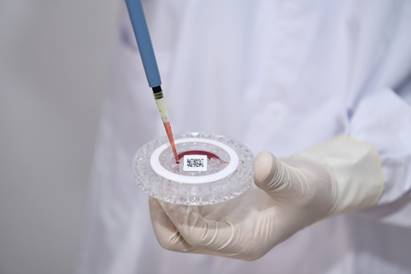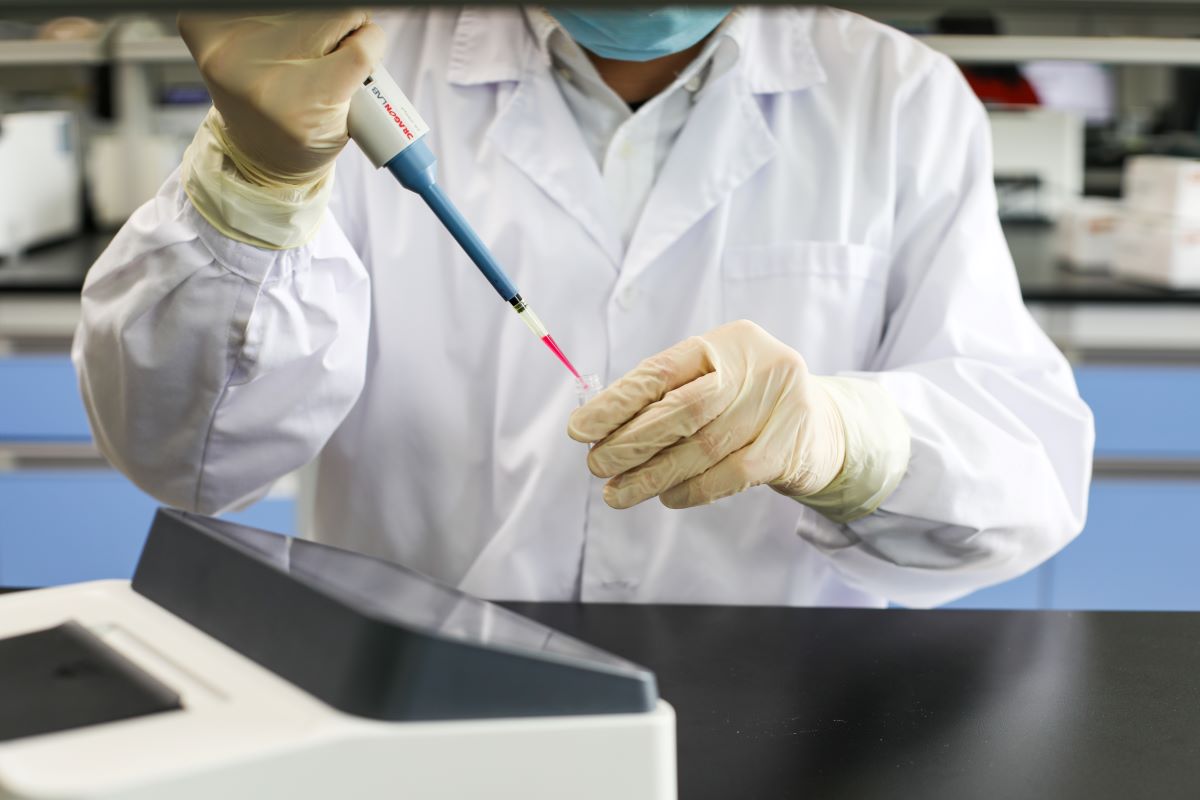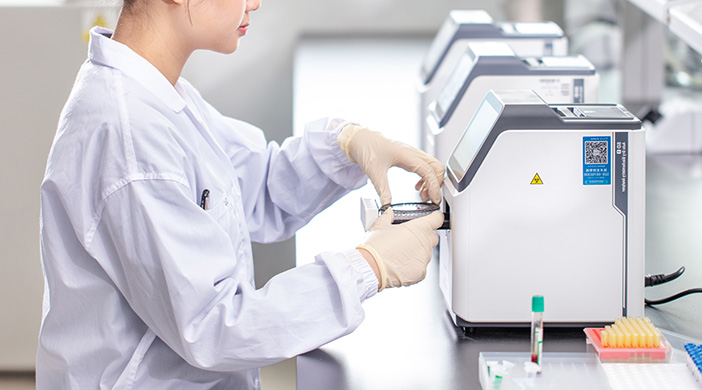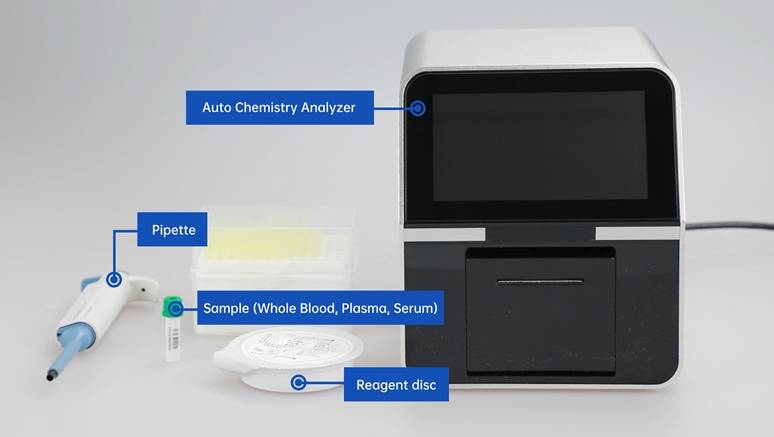Biochemical testing is one of the important tools commonly used in clinical diagnosis. At present,
dry chemistry (biochemical) analyzers have also been more widely used. What is a dry biochemistry analyzer? How to use this biochemical machine?
Principle of dry biochemical analyzer
Dry chemistry, also known as solid-phase chemistry, uses solid-phase reagent technology with multilayer films. Simply add the liquid sample directly to a reagent carrier that has been solidified in a special structure, i.e. the reagents of dry chemistry. Using the water in the sample as a solvent, the reagents cured in the carrier are dissolved and then chemically reacted with the components to be measured in the sample. This allows for analytical determination to yield the concentration or activity of the object to be measured.
The Seamaty
SD1 fully automated dry biochemistry analyzer has a built-in centrifuge. This biochemical machine is based on Lambert's law. In addition to this, it incorporates microfluidic technology, which is more accurate than traditional biochemical tests. In addition, this dry chemistry analyzer replaces the xenon lamp used in traditional biochemistry with a halogen lamp, which is smaller in size. However, its light intensity varies less than 1%, which is better than traditional biochemistry light source performance.
How to use the dry chemistry analyzer?
Compared to traditional wet biochemical analyzers, dry biochemical analyzers have the advantage of being more lightweight, faster detection, and simpler to operate. As a dry biochemistry analyzer manufacturer, Chengdu Seamaty Technology Co., Ltd. has been deeply involved in POCT equipment for many years. The following Seamaty SD1 dry biochemistry analyzer is an example to explain the use of this small biochemistry machine.
Simply put, this small biochemistry machine from Seamaty requires only 3 steps of operation and 12 minutes to obtain biochemical test results.
1. Add 90-120 μL of blood sample
Turn on the
biochemistry machine, remove the corresponding reagent tray and add the sample. (The matching pipette gun uniformly uses the first gear). Blood samples support whole blood, because the biochemistry instrument built-in centrifuge, so no sample pre-disposal, only 90-120μL heparin series anticoagulated whole blood, plasma or serum.
Here is a brief explanation of the difference between whole blood, plasma or serum.
①Whole blood: The whole blood after anticoagulation is whole blood. It is mostly used in the determination of blood cells, blood routine, and blood sedimentation.
②Plasma: The yellowish liquid obtained from whole blood after centrifugation to remove blood cells is plasma. It is mostly used for the determination of coagulation, biochemistry and other aspects.
③Serum: Blood is not treated with anticoagulation, and for a period of time after the blood is drawn, the blood is first coagulated into a whole under the action of coagulation factors. After a further period of time or centrifugation with a centrifuge, some clear, yellowish liquid will be separated, and this liquid is called serum. Compared with plasma, it does not contain fibrinogen. It is mostly used for the determination of blood biochemistry, immunity, etc.
2. Place in reagent tray
Click on the biochemistry machine screen ready to test button. The plate holder of the biochemistry machine will be extended. Then place the biochemical reagent tray flat on the tray holder. Click to start the test. Then the plate rack will automatically return to the chamber. This instrument has no internal night circuit, pump valve and other perishable parts, no need for maintenance and easy to carry. (Sample information such as medical record number, age, gender, etc. can be entered during the test)
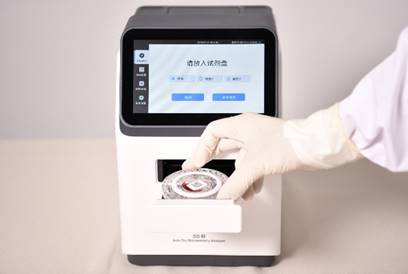
3. 12 minutes automatic result
When the 12-minute countdown is over, the reagent tray will automatically exit the chamber. The biochemistry machine will automatically print a report and the round of testing is over. This dry biochemistry machine has no random error, no cross-contamination, and the instrument automatically completes the calibration in real time.
The Seamaty SD1 biochemical test results are printed in 3 ways
①Built-in printer
This biochemistry machine comes with a built-in thermal printer (small paper strip report), which is more suitable for out-of-home diagnostics and other special cases.
②External printer
This dry biochemistry analyzer supports direct connection to a printer that comes standard with HP PCL3GUI printer language, such as HP Deskjet 1010, and selects the external printing mode by directly connecting to the matching printer through the USB port.
③ PC data printing
In addition to this, the biochemistry machine can also manage data and implement printing through a computer.
The management system of this automatic dry biochemistry analyzer is also very powerful.
This auto chemistry analyzer can be connected to various hospital Lis systems. The instrument can realize the PC version of biochemical management system. Instrument WIFI networking, automatic data upload (no distance limitation). In addition. Using biochemical intranet system, connect to computer through LAN (no need to connect to public network). There is another way to implement data transfer through serial port, wired to a computer.

